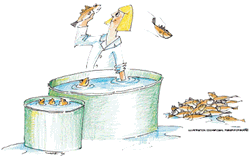![]()
Genetic improvement of disease resistance through selective breeding is a sustainable way to constrain these losses. Consequently, disease resistance is one of the breeding objectives for various aquatic species. The general approach is to infect fish of known family structure in experimental conditions with a causative agent, and use the survival information in genetic evaluation.
Survival in challenge test predicts well survival in field conditions. This approach has proved to be an effective tool for genetic improvement of disease resistance. Since cod is a new species in aquaculture, it is not apparent which diseases will be the most hazardous.
Due to recognised outbreaks in cod aquaculture together with readily available challenge test protocol, developed by Fiskeriforskning, vibriosis was a natural choice for the first genetic study.
 |
A challenge test was conducted to detect between-family variation in survival after infection with Vibrio anguillarum, the bacteria causing vibriosis. The data comprised 3576 individuals representing 50 full-sib families and both coastal (CC) and northeast Arctic cod (NEAC) populations.
The overall survival at the termination of the experiment was 13.6 %. In this study, CC (17.0 % survival) proved to be more resistant to vibriosis than NEAC (10.3 % survival). The survival percentages for different families varied from 1.4 % to 37.9 %, and the patterns of survival were significantly different.
Preliminary estimates of heritability for number of days survived after challenge ranged from 0.10 to 0.18. These first results indicate that survival data can successfully be used in selecting more vibriosis resistant Atlantic cod within the breeding programme.
July 2006


